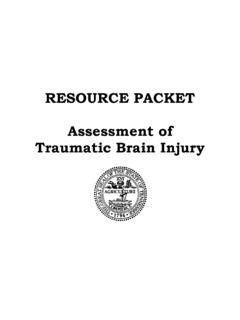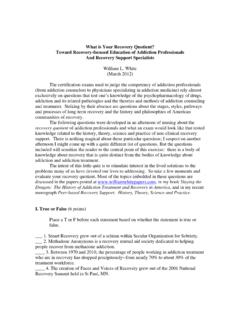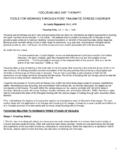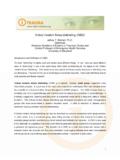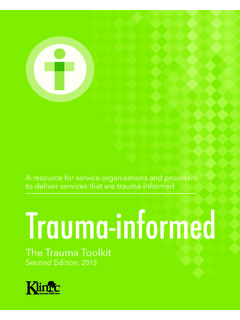Transcription of Course Manual: Modules 1 -5 Part A Online …
1 Course manual : Modules 1-5 Part A Online Component To assist you as you complete the Online component, the following pages comprise the sections from the Part A Course manual that cover the first five Modules from this Course . Your complete Course manual will be provided to you at the live Course . Remember, completion of this Online component and a 75% pass on the final test at the end of the five Modules is required for your entry into the live Course . The Online component will take approximately five hours to complete. This projected time includes watching the content and videos, reviewing before and after each quiz, and also the review of the entire component following the final test completion before attending the live Course .
2 Part A : The Lumbar Spine module One Page 2 Introduction and Epidemiology Copyright The McKenzie Institute International 2016 Dec-16 module ONE INTRODUCTION AND EPIDEMIOLOGY Objectives By participating fully with this module , a participant will be able to: 1. Describe the cardinal features of the McKenzie Method of Mechanical Diagnosis and Therapy (MDT) and contrast it with other management approaches. 2. Describe the major epidemiological factors associated with low back pain. 3. Describe the risk and prognostic factors of low back pain. Part A : The Lumbar Spine module One Page 3 Introduction and Epidemiology Copyright The McKenzie Institute International 2016 Dec-16 module ONE INTRODUCTION AND EPIDEMIOLOGY 1.
3 Describe the cardinal features of the McKenzie Method of Mechanical Diagnosis and Therapy (MDT) and contrast it with other management approaches. Cardinal features Classification of sub groups (syndromes) - based on symptomatic and mechanical responses Focus on centralisation and directional preference Self-treatment Progression of forces Patient education Recognises major aspects of back pain experience Recurrent / episodic nature of back pain Role of everyday mechanical loading Importance of patient involvement in therapy Psychosocial aspects of back pain experience Contrast with other treatment approaches Repeated movements for assessment and management Emphasis on patient independence Avoidance of therapist dependency Use of minimal intervention Combination of exercise and therapist intervention as necessary Exercises used for pain relief 2.
4 Describe the major epidemiological factors associated with low back pain. Prevalence of back pain 50-80% of adult population will experience back pain at some point in their life 40% have back pain in any one-year Back pain is normal The natural history of back pain Considerable variability in natural history Recurrent episodes and persistent symptoms are common Acute and chronic definitions are insufficient to describe reality of back pain Implications of back pain Back pain is one of the commonest causes of disability in working population Total costs of back pain are larger than for any other disease for which economic analysis is available Medical costs represent 7% to 34% of total societal costs Part A.
5 The Lumbar Spine module One Page 4 Introduction and Epidemiology Copyright The McKenzie Institute International 2016 Dec-16 25% to 40% of those with back pain seek healthcare Back pain accounts for 3% to 5% of primary care physician consultations Management Little or no evidence to support the use of: Ultrasound, laser, traction, thermal modalities, electrical stimulation, acupuncture, TENS, bed rest for back pain or sciatica, back school in a non-occupational setting. NSAIDs provide short-term pain relief in acute back pain, not clearly better than simple analgesics, none proven better. Not proven to be helpful in chronic back pain or sciatica Some evidence to support a role for: Education, behavioural therapy, manipulation short-term benefit in some sub-groups, and exercise.
6 3. Describe the risk factors and prognostic factors for back pain. Risk factors Three classes of risk factor: 1. Individual and lifestyle History of back pain 2. Physical or biomechanical Heavy or frequent lifting Whole body vibration (as when driving) Prolonged or frequent bending or twisting Postural stresses (high spinal load or awkward postures) 3. Psychosocial Prognostic factors Psychosocial factors have a role in the development of chronic pain and disability. Heavy manual work, sitting occupation, low job satisfaction, lower income associated with poor prognosis. Leg pain, sciatica, previous back pain, lack of centralisation associated with poor prognosis.
7 Part A : The Lumbar Spine module One Page 5 Introduction and Epidemiology Copyright The McKenzie Institute International 2016 Dec-16 PREDISPOSING FACTORS MCKENZIE IDENTIFIES TWO LIFESTYLE FACTORS PREDISPOSING TO LBP These appear to have a close association with the development of back pain but lack support from the literature to date. 1. Poor sitting posture Slouched sitting places the spine in flexion and is similar to the fully flexed standing posture. In the sitting position the more the lumbar spine approximates kyphosis, the higher the intradiscal pressure; the more the spine approximates lordosis, the lower the intradiscal pressure. The slouched sitting position also causes overstretching of posterior spinal ligamentous structures at end range.
8 Some LBP is caused and nearly all LBP is aggravated and perpetuated by poor sitting. 2. Frequency of flexion From rising in the morning until returning to bed at night people are predominantly in flexed spinal postures and activities, and rarely extend. Frequent and sustained flexion stresses are present during work and during daily activities. These two predisposing factors, when combined, eventually lead to a loss of extension. Part A : The Lumbar Spine module One Page 6 Introduction and Epidemiology Copyright The McKenzie Institute International 2016 Dec-16 REFERENCES FOR module ONE 1. Airaksinen O, Brox JI, Cedraschi C, Hildebrant J et al. European guidelines for the management of chronic non-specific low back pain.
9 Eur Spine J 2006;15:S192-S300. 2. Dunn KM, Jordan KP, Croft PR. Contribution of prognostic factors for poor outcome in primary care low back pain patients. Eur J of Pain 2011;15:313-319. 3. Gilkey DP, Keefe TJ, Peel JL, Kassab OM, Kennedy CA. Risk factors associated with back pain: a cross-sectional study of 963 college students. J Manip Physiol Ther 2010;33:88-95. 4. Hayden JA, Dunn KM, van der Windt DA, Shaw WS. What is the prognosis of back pain? Best Pract & Res Clin Rheum 2010;24:167-179. 5. Hoy D, Bain C, Williams G, March L, Brooks P, Blyth F, Woolf A, Vos T, Buchbinder R. A systematic review of the global prevalence of low back pain. Arth & Rheum 2012;64:2028-2037. 6. Maniadakis N, Gray A (2000).
10 The economic burden of back pain in the UK. Pain 7. Martin BI, Deyo RA, Mirza SK, Turner JA, Comstock BA, Hollingworth W, Sullivan SD. Expenditures and health status among adults with back and neck problems. J Am Med Assoc 2008;299:656-664. 8. Mitchell T, O Sullivan PB, Burnett A, Straker L, Smith A, Thornton J, Rudd CJ. Identification of modifiable personal factors that predict new-onset low back pain: a prospective study of female nursing students. Clin J Pain 2010;26:275-283. 9. Pengel LHM, Herbert RD, Maher CG, Refshauge KM. Acute low back pain: systematic review of its prognosis. Br Med J 2003;327:323-325. 10. Van Middelkoop M, Rubinstein SM, Kuijpers T, Verhagen AP, Ostelo R, Koes BW, van Tulder MW.



